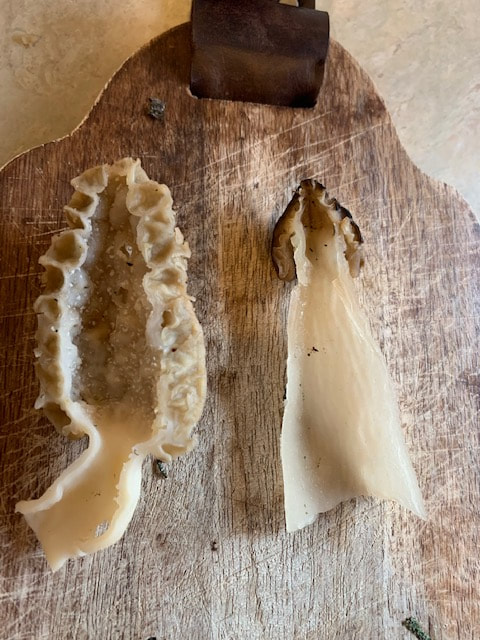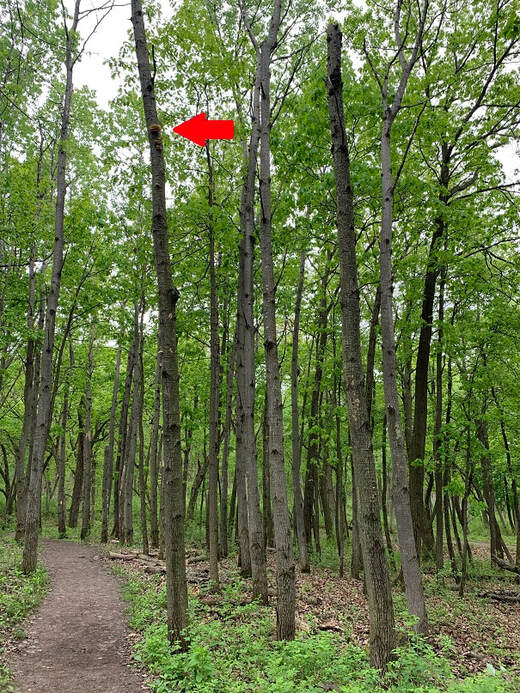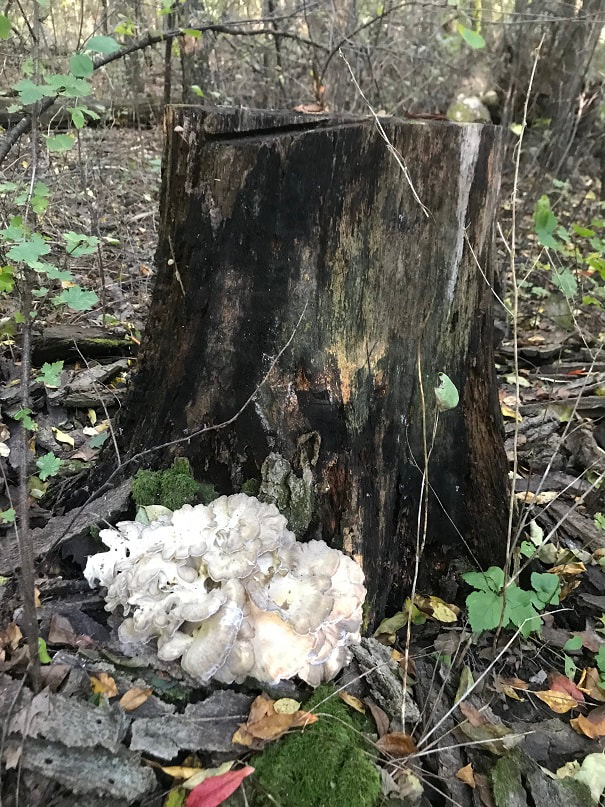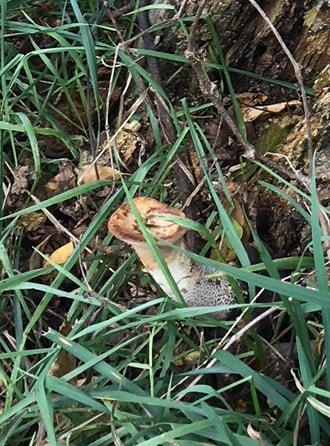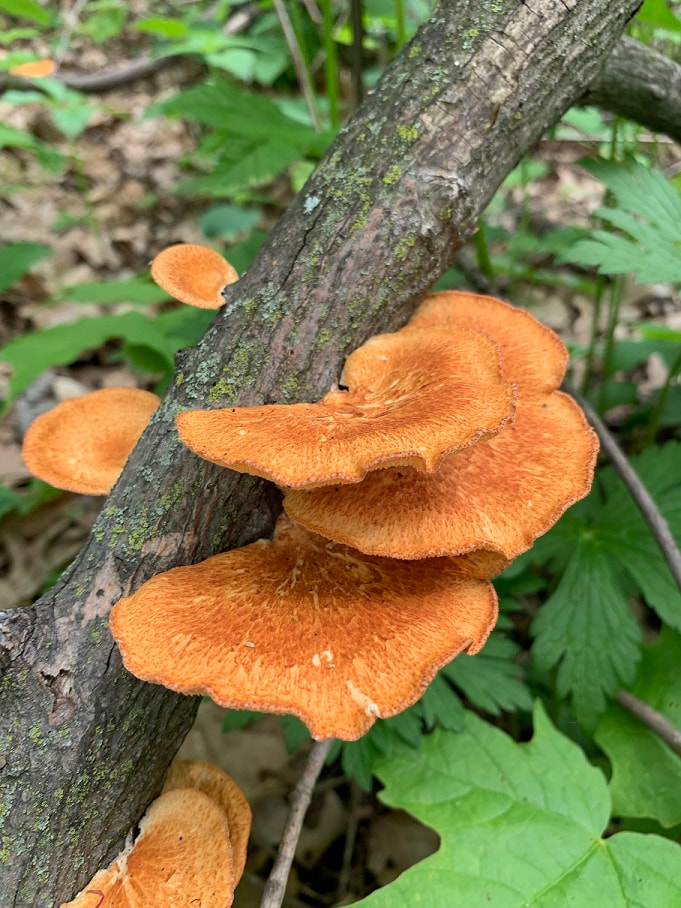Hunting mushrooms in Wisconsin
I hope you enjoy this mushroom hunting guide! On this page you will find information on how to find yummy Wisconsin Mushrooms along with photos of what they look like. I hunt for mushrooms in Southern Wisconsin, so the info and photos on this page is relative to that region.
There are three sections on this page:
Section 1: Updates on when I am finding mushrooms (I try to update this when I find them, but I don't always write it down)
Section 2: Mushroom hunting tips
Section 3. Photo's of mushrooms and information regarding local Wisconsin mushrooms
There are three sections on this page:
Section 1: Updates on when I am finding mushrooms (I try to update this when I find them, but I don't always write it down)
Section 2: Mushroom hunting tips
Section 3. Photo's of mushrooms and information regarding local Wisconsin mushrooms
May 11, 2024: Morels are to be found now!
Update April 20, 2024: crazy! Found these morels in Waukesha County today. 3 weeks earlier than normal. They were near a stream on a steep south facing berm so I guess the southern exposure warmed the ground up enough for them. I wasn’t even mushroom hunting as this time of year is usually too early.
-Update May 16 , 2023: Yellow Morels, Waukesha County WI
-Update Oct 3 , 2022: Two nice fresh Hen of the Woods and the largest colony of Chicken of the Woods I've ever seen.
-Update August 15 - July 14, 2022: Chanterelles found
-Update Oct 10, 2021: Found a nice Hen of the Woods today
-Update: August 2021: Haven't been keeping up with my updates this year! There have been Chanterelles throughout August this year and I picked what looked like the last one on the forest floor today.
-Update: Oct 23, 2020: Got skunked this year on Hen of the Woods, which is a first I think as I always look in the same forest and they are always there in Late September into October. I will dance even more next time I find one!
-Update: July 11, 2020: Found Ghost Chanterelles (Cantharellus phasmatis) today here in Wisconsin.
-Update: July 11, 2020: Found Ghost Chanterelles (Cantharellus phasmatis) today here in Wisconsin.
-Update: May 18, 2020: Morels are out to be found in Wisconsin!
-Update: May 15, 2020: I think the last frost is finally behind us. After cold weather over the past couple weeks, we had good rain and now a couple warm days in the 60s. Found my first morels of the season today over lunch! Just little ones , 1” tall, but they are definitely emerging here in Southern Wisconsin.
-Update August 31, 2019: Chanterelles are in the forest and found a nice Chicken of the Woods today also.
-Update May 28, 2019: Aspen Oyster Mushrooms are ready for harvesting
-Update October 4, 2018: Fresh grown, large Hen of the Woods found.
Step-by-Step Guide for Finding Mushrooms to eat (the second step is the most important!):
"Hunting" is certainly a good word to describe the pursuit of yummy mushrooms in the deep dark woods. It is a simple and fun activity, and the results are rewarding and tasty indeed. Below I show examples of five gourmet wild mushrooms that we have found in southeast Wisconsin: Hen of the Woods, Chicken of the Woods, Morels, Chanterelles, and Aspen Oyster Mushrooms; below those are some other mushrooms that I identified, but that I don't eat. All photo's taken by the Argo Builder.
Step 1: Research what it is you're looking for, and what season it emerges in, and what trees it grows near or on.
SPRING: In spring we look for Morels that grow near dead Ash, elm, or apple trees, I have found success looking in the woods near small rivers but have also found them in the woods nowhere near a river. In late May and June we look for Aspen Oyster mushrooms, which grow on standing dead Aspen trees.
SUMMER: In summer we look for Chanterelles in a forest of living oak and hickory. Chanterelles don’t grow on dead wood, they grow from the ground, it's not a Chanterelle if it isn't growing from dirt. Chicken of the Woods can be found on the trunks and near the base of Oak trees in summer in this area.
AUTUMN: Chicken of the Woods may still be found in early Fall. Fall is when we look for Hen of the Woods mushrooms that grow at the base of Oak trees or stumps in the fall. You will find them within a couple feet of the base of oak trees or right at the base of the tree.
More detail and photos of these mushrooms may be found below.
Step 2: Walk into the woods
SPRING: In spring we look for Morels that grow near dead Ash, elm, or apple trees, I have found success looking in the woods near small rivers but have also found them in the woods nowhere near a river. In late May and June we look for Aspen Oyster mushrooms, which grow on standing dead Aspen trees.
SUMMER: In summer we look for Chanterelles in a forest of living oak and hickory. Chanterelles don’t grow on dead wood, they grow from the ground, it's not a Chanterelle if it isn't growing from dirt. Chicken of the Woods can be found on the trunks and near the base of Oak trees in summer in this area.
AUTUMN: Chicken of the Woods may still be found in early Fall. Fall is when we look for Hen of the Woods mushrooms that grow at the base of Oak trees or stumps in the fall. You will find them within a couple feet of the base of oak trees or right at the base of the tree.
More detail and photos of these mushrooms may be found below.
Step 2: Walk into the woods
Step 3: Keep a keen eye and look for the right environment, and tree type, where your quarry may be hiding. Do not eat anything that you are not 100% certain is the mushroom you are looking for. Do not rely only on the photo's on this page for mushroom identification. If in doubt, don't risk it, there are deadly poisonous mushrooms. That said, be not afraid! Just be informed. Get a mushroom identification guide. I used the following sites for identification information:
http://www.michiganmorels.com/morels2.shtml
http://americanmushrooms.com/edibles1.htm
http://www.michiganmorels.com/morels2.shtml
http://americanmushrooms.com/edibles1.htm
Mushroom Hunting Tips:
- Use a mushroom identification guide and be completely certain that you have positively identified the mushroom before eating it. If in doubt, do not eat it, there are deadly poisonous mushrooms.
- Take a sharp knife to cut the mushroom off just above the ground. If you are hunting Hen of the Woods mushrooms, take a long knife as the base of the mushroom can be a long way in from the outside of the big mushroom.
- Carry your harvested mushrooms out of the forest in a mesh bag so that spores from the mushroom can fall into the forest and perhaps yield new mushrooms in the future.
- Rainfall can spur-on mushroom growth, looking a couple days after rainfall can be a good idea.
- Mushrooms are natural little guys that live close to the ground, and other little critters and bugs live around and in them. Be not afraid of a wee little insect you may find. There will likely be some in a Hen of the Woods.
- I clean up the mushroom with a dry soft paintbrush and usually cook them right away. A big one can be kept in the refrigerator, for example I may eat a large Hen Of The Woods over the course of a week.
- I slice them, clean them, get rid of any critters, and then sauté them in butter with garlic. Sometimes I add in a bit of soy sauce.
- Never eat raw wild mushrooms, always clean and cook them well.
- Probably best to wear long pants as you may be climbing through underbrush, there are mosquitoes and tics around, so one could wear bug repellent, or do what I do which is to shake out my clothes wellwash them, take a shower and check each other out for ticks same day as walking through the woods.
Edible Wisconsin Mushrooms, starting in Spring and progressing through the year:
Morels:
Morels are one of the more sought-after wild mushrooms in Wisconsin. They emerge in spring here, and may be found at the wood edge or in the woods, growing from the ground; they like to grow around dead ash trees. Well drained soils or sandy soils where the woods meet a stream are a good place to look. They may also be found around Elm , poplar, or apple trees, and I have found them where none of those trees can be found nearby. The first Morels of spring are typically found on warm sunny southern facing slopes, and spread from there as the season goes on. I have read that they start grow when the ground temperature is 55deg and stop growing when the ground temperature reaches 62deg, but have not verified that myself. In Wisconsin that puts Morel season generally in late April through mid June , depending on the year and where in Wisconsin you are looking.

Morel Mushroom Cross Sections, including the poisonous False Morel, which is not a Morel and which is not edible. Use this website at your own risk! Please research well what you might eat and if in doubt, do not eat it. The author claims no responsibility for anyone who uses this information and eats a poisonous mushroom.
Aspen Oyster Mushroom
Aspen Oyster Mushrooms are easy to spot, as they are bright white. They grow on dead Aspen trees that are still standing. Here in Wisconsin they emerge in late May. They may be found high up on the tree, as shown in the picture below. They may also be found lower down where they are easier to harvest. They taste great sauteed with garlic, green onion, salt and pepper.
Chanterelles:
Chanterelles grow in Wisconsin in hardwood forests, in summer and early fall. They grow from the ground, not from dead wood. the ones I find are orangish, and 2 to 3.5" across on the top. Underneath, they have firm ridges that run along the underside and then the ridges split off into multiple ridges towards the outer edge of the underside of the cap. They do not have thin fragile "gills" that break when you run your finger across them. The video below shows an imposter mushroom followed by a chanterelle......my apologies for tearing the chanterelle from the ground rather than cutting it, I wanted to show the difference in the two mushrooms and forgot my knife. I did not harvest any by pulling them up...which is considered poor form. I have learned that there are many species, over 10, which share the general characteristics of "Chanterelles". From what I gather, all Chanterelles have "false gills" which are firmly attached ridges under the cap, as opposed to fragile "gills" which are easily broken and which no Chanterelles have (easily broken gills, that is). As I update this paragraph in July of 2020, I add my identification of "Ghost Chanterelles" Cantharellus phasmatis pictured at the end of the Chanterelle photos below.
The Jack o Lantern mushroom is poisonous and looks similar to the Chanterelle. Here is a good video on the differences: https://www.youtube.com/watch?v=9aOwgaIFKMY
Chicken of the Woods
This is a large bright orange mushroom with many large petals (I know they're not technically called petals...). The edge of the mushroom is lighter, almost white or yellowish. The one in the photo is about 2 feet in diameter. This mushroom is very tasty and meaty; you could almost think it's chicken; hence the name! There are two different varieties: one is white on the underside of the mushroom petals ( L. Cincinnatus is the "white pored" chicken of the woods), and the "Sulfur Shelf" Chicken of the Woods (L Sulphureus, which is yellow on the underside of the petals).
The White Pored Chicken of the Woods like the one in the picture below, grows from roots of oak trees; while the other variety grows from the trunk of oak trees. I have read that they grow on other trees also, but to be wary of eating Chicken of the Woods growing from trees other than Oaks. Be sure to always cook wild mushrooms well; never eat raw wild mushrooms. Here's a good page on Chicken of the Woods https://botit.botany.wisc.edu/toms_fungi/jul2001.html
The White Pored Chicken of the Woods like the one in the picture below, grows from roots of oak trees; while the other variety grows from the trunk of oak trees. I have read that they grow on other trees also, but to be wary of eating Chicken of the Woods growing from trees other than Oaks. Be sure to always cook wild mushrooms well; never eat raw wild mushrooms. Here's a good page on Chicken of the Woods https://botit.botany.wisc.edu/toms_fungi/jul2001.html
Hen of the Woods, also known as Maitake:
Hen of the Woods mushrooms grow here in Wisconsin in Autumn. They grow on or near the base of Oak trees or stumps when the air temp is around 50-60degrees. We have found them in September and October in Wisconsin. They are a large mushroom as can be seen in the photos below. Even the little ones are fairly large. The best advice I can give is to look all the way around the trunk of the Oak......Many times I have looked at a trunk and seen nothing, and then thought “well I’ll peek on the other side” and voila there’s one hiding!.....you can only see half of the trunk at a time. A Hen of the Woods is one mushroom that has many broad petals or fronds (my description and terms) that I pull apart by hand back in the kitchen. After brushing the petals off with a paint brush you can cook em up and enjoy.

What a beauty! A good size Hen of the Woods found in southeast Wisconsin at the foot of an old Oak. The mushrooms grow in northern Japan and in North America, and maybe elsewhere, I don't know. In Japan, they are called "Maitake", which I am told means "dancing mushroom" on account of the happy emotion that causes one to dance upon finding one.
Other Wisconsin Mushrooms....that I don't eat:
Safety note: I am not an expert, I am a hobbyist. Do not eat any mushroom that you are not 100% sure you have identified correctly and 100% sure is safe to eat. Use any photos or information on this site at your own risk. If you find a misidentified mushroom on this site, please email [email protected]
Destroying Angel
This mushroom's name speaks for itself; this is a deadly mushroom and very common in late summer. They look nice and bright white, but stay away from them.
Artist's Conk
A pretty, perennial, shelf mushroom. Do not eat them.
Pheasant's Back, also known at Dryad's Saddle
Old Man of the Woods
Giant Puffball Mushroom
Russula Emetica: Poisonous
Pretty , red-capped mushroom, cap and stalk are white on the inside as seen in the second photo below. Photo is from fall in a mixed Oak and Hickory forest.
Elm Mushroom
White mushroom that grows from tree trunks, often high up the trunk, from a wound or old hole where a branch used to come out of the trunk. Grows most often on Elm and Box Elder trees. I took this picture during the 2nd week of November here in Wisconsin. The mushroom grows in surprisingly cold conditions, for example there have already been many freezing conditions here over the last month.
Crown-Tipped Coral Mushroom
This mushroom looks like coral and has little spikey crowns on the ends of its growths. Some people eat it, some say it can be poisonous; I don't eat it. It is a pretty mushroom and I have found multiple growing on the same old dead log.
Polyporus Mori, Small Orange Shelf Bracket Mushroom
Emerges and spring and hangs around into summer. I don't eat these. The ones in the picture are about 3" across.
The Stinkhorn!!
Oh you memorable, aptly-named Stinkhorn, you cannot help but be that which you are, and you have your place and your purpose.
I was picking Blackcap Berries in the yard with my kids and from a waft of deathly smelling air, figured there was a dead animal in the bushes. Upon investigating the underbrush I found these uniquely disgusting mushrooms, called Stinkhorns. They look like gross, alien pink slimy worms emerging from the ground. On their tops they have a repulsive dark green brown slime. They smell like death. They are very fast growing and short lived. They consume and give new life to dead plant matter and they serve their purpose in their own way. Live your stinky life Stinkhorns!











